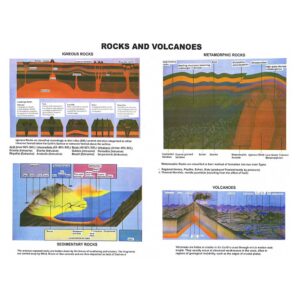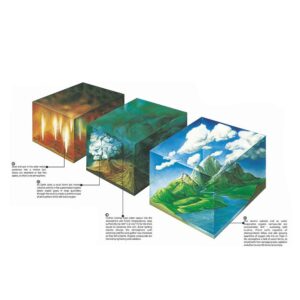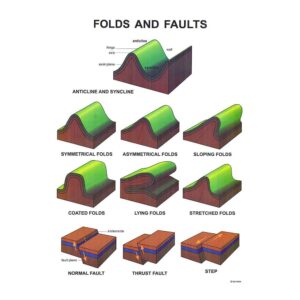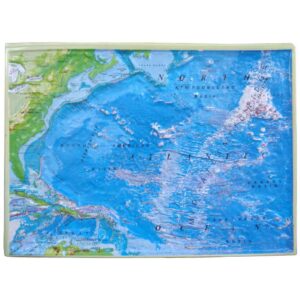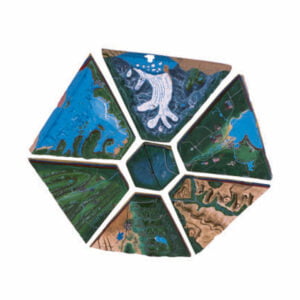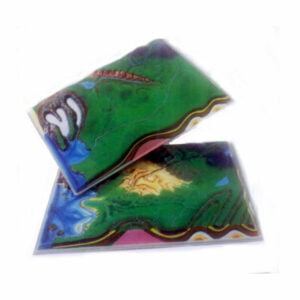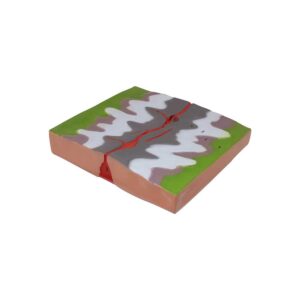Biology
-
Earth Science
Rocks and Volcanoes
This comprehensive model showcases the formation and characteristics of sedimentary, igneous, and metamorphic rocks, along with a detailed depiction of volcanoes. It visually explains how each rock type is formed through processes like sediment deposition, volcanic activity, and heat/pressure transformation. The volcano section demonstrates different eruption types and magma flow. Perfect for geology lessons, it provides an in-depth understanding of Earth’s rock cycle and volcanic activity.
BG19025 -
Earth Science
Restless Earth
This detailed model illustrates the process of sea-floor spreading, highlighting the formation of oceanic crust, subduction zones, midocean ridges, and continental drift. It visually represents tectonic plate movements, showing how new crust forms at mid-ocean ridges and is recycled at subduction zones. Ideal for geology and earth science education, this model provides a clear understanding of plate tectonics and the dynamic processes shaping the ocean floor and continents.
BG19026 -
Earth Science
Oxygen and Carbon Cycle in Nature
This educational model illustrates the oxygen and carbon cycles in nature, showcasing how these essential elements move through the atmosphere, plants, animals, and the environment. It highlights key processes like photosynthesis, respiration, combustion, and decomposition. Ideal for teaching biology and environmental science, the model helps students understand the balance and interaction between carbon and oxygen in ecosystems.
BG19027 -
Earth Science
Formation of Rocks
The processes that create sedimentary, igneous, and metamorphic rocks. It visually explains how rocks are formed from magma, sediment, and metamorphic processes, showing how they transform from one type to another over geological time. Ideal for educational use, it provides a clear, interactive understanding of rock formation and the dynamic nature of Earth’s geology.
BG19028 -
Earth Science
Volcanic System
This model illustrates the key parameters of volcanic activity, including magma formation, eruption types, and lava flow. It also demonstrates post-eruption features such as volcanic craters, calderas, and lava plateaus. Ideal for educational purposes, the model provides a comprehensive view of how volcanoes form, erupt, and evolve, helping students visualize the dynamic processes and geological structures associated with volcanic activity.
BG19029 -
Earth Science
Glacial Landscape
This model showcases landscapes before and after glacial action, highlighting the transformative effects of glaciers. It illustrates how glaciers shape terrain through processes like erosion, deposition. Ideal for studying glaciation, the model provides a clear, comparative view of how glaciers sculpt and reshape landscapes over time.
BG19030 -
Earth Science
Air & Water Pollution
A model showing factors causing air and water pollution typically includes key contributors such as industrial emissions, vehicle exhaust, and agricultural runoff. Industrial activities release pollutants like sulfur dioxide and particulate matter into the air, while vehicles contribute carbon monoxide and nitrogen oxides. Water pollution arises from agricultural runoff carrying pesticides and fertilizers, as well as industrial discharges containing harmful chemicals. The model often illustrates how these pollutants interact with the environment, leading to detrimental effects on ecosystems and human health.
BG19031 -
Earth Science
Origin of the Earth
A model illustrating the stages of Earth’s formation typically begins with the primordial accretion of dust and gas around 4.6 billion years ago, leading to the formation of a molten planet. As the planet cooled, a solid crust formed, followed by the development of oceans and the early atmosphere. The model may then depict the formation of the first continents through volcanic activity and tectonic processes. Over time, the gradual development of complex life forms and the stabilization of climate conditions contributed to the Earth as we know it today.
BG19032 -
Earth Science
Folds & Faults
A model depicting folds and faults in land illustrates how tectonic forces shape the Earth’s crust. Folds, such as anticlines and synclines, form when rock layers are compressed and bend without breaking. Faults, including normal, reverse, and strike-slip faults, occur when rocks fracture and slip due to tectonic stress. The model helps visualize these geological processes and their effects on landscapes, showing how mountain ranges, valleys, and other landforms are created and modified over time.
BG19033 -
Earth Science
Rock Cycle Model
A model depicting coastal and mountain terrain in natural color relief with a cross-section diagram of a typical volcano, sized 60×45 cm, provides a detailed, three-dimensional view of these geological features. The volcano cross-section reveals the internal structure, including the magma chamber, volcanic conduit, and crater, with surrounding layers of volcanic rock. This model offers an educational perspective on how coastal and mountain landscapes interact with volcanic activity.
BG19045 -
Earth Science
Ocean Features Model
A 45×60 cm relief map of the North Atlantic Ocean, highlighting a typical section of the ocean floor, provides a clear and detailed view of key oceanic features. This map includes prominent features such as mid-ocean ridges, abyssal plains, and deep-sea trenches, making it easy to identify and study major oceanic structures. Accompanied by a comprehensive lesson plan, the map serves as an educational tool for understanding ocean floor topography and the geological processes that shape it. The lesson plan helps guide instruction on the formation and significance of these features
BG19046 -
Earth Science
Land form Model
The 90×90 cm model, composed of eight interconnected landform sections, offers a comprehensive investigation into diverse geographical and geological features. This continuous model displays a range of terrains including mountains, lakes, rivers, deserts, glaciers, coastlines, canyons, and cultural landmarks. Each section seamlessly connects to create a cohesive representation of Earth’s varied landscapes. Accompanied by an informative lesson plan, the model provides an engaging educational tool for studying the formation and interaction of these landforms, and their impact on human culture and environment.
BG19048 -
Earth Science
Comparative Terrain Model
The set of two 45×60 cm landform models features overlays that represent ancient mountain formations, which can be removed to compare with the base models showing their evolved state over millions of years. These models include cross-sections that illustrate various mountain types such as volcanic, fault-block, glaciated domes, and folded mountains. This interactive design allows for a clear visual comparison of geological changes over time. Accompanied by a detailed lesson plan, the models offer an effective educational resource for understanding the dynamic processes that shape mountain landscapes and their historical transformations.
BG19050 -
Earth Science
Water Cycle Model
Creative model For Student to duplicate the individual processes of the water cycle (evaporation, condensation & precipitation). With set of ten coloured study cards for students understanding of the water cycle & awareness of the various states of water. Requires a heat lamp, not included.
BG19052 -
Earth Science
Water Table Model
This model illustrates the upper level of an underground surface where soil or rock is permanently saturated with water, known as the water table. It clearly depicts how the water table separates the saturated underground water zone from the overlying capillary fringe, or zone of aeration.This visual representation helps in understanding groundwater distribution and the dynamics of water flow within different subsurface layers.
BG19055 -
Earth Science
Open Pit Mine Model
The open pit mine model provides a detailed representation of a large, excavation-based mining operation. It showcases the various stages of mining, from the initial removal of surface layers to the extraction of valuable minerals or ores from the underlying rock.
BG19058 -
Earth Science
Underground Mine Model
This model demonstrates underground mining techniques used when an ore body is located at significant depths below the surface. The model highlights various underground mining methods, such as shaft mining and sublevel stopping, showing how miners create tunnels and shafts to access and extract the ore. It also emphasizes the engineering challenges and safety considerations involved in reaching and retrieving valuable resources from deep underground.
BG19060 -
Earth Science
The Lava Legacy Plateau (Volcanic Action)
This model demonstrates lava plateau formation, highlighting lava layering from multiple eruptions, fissures as lava pathways, and the magma source. It features fissures, molten lava, cinder cones, and lava layers (new, older, oldest), alongside a plain and magma chamber, offering a detailed view of volcanic processes and geological stratigraphy typical of a lava plateau. Highly featured model with size of 40 x 35cm
BG19086A

